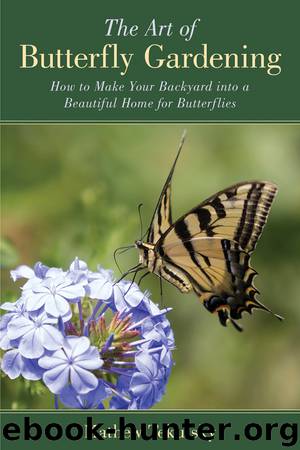The Art of Butterfly Gardening by Mathew Tekulsky

Author:Mathew Tekulsky
Language: eng
Format: epub
Publisher: Skyhorse Publishing
Published: 2015-01-01T05:00:00+00:00
Gulf Fritillary
Giant Swallowtail
Great Southern White
Spicebush Swallowtail
Orange-barred Sulphur
CHAPTER 8
How to Rear Butterflies
Rearing butterflies, an easy and rewarding activity, can enhance the enjoyment of one’s butterfly garden immensely. First you’ll need the butterflies themselves, which you should be able to gather in various stages of development from your garden and from places around your neighborhood or farther afield.
I find it very effective to watch a female oviposit, and then I can bring her eggs home to rear them. For one thing, it’s easier to find a female in the wild than an egg. I also know (or at least I’m pretty sure) the eggs will be safe at home, and I feel intimately connected to each butterfly that results from one of these eggs.
When using this technique (or when collecting eggs on their own in the wild), be sure to bring home the stems with the leaves on which the butterfly has laid her eggs. If you immediately place these stems in water, the foodplant should remain fresh for a number of days, or, depending on the foodplant, as long as a week or two. Since eggs usually take about a week to hatch, this will provide the newly hatched caterpillars with fresh enough leaves on which to start feeding.
Many butterfly rearers capture a female and place her in a cage with some potted foodplant or cut foodplant in water. Most females will have mated by the time they’re caught, so there’s a good chance that any captured female will lay fertile eggs, usually within a day or so. Females usually require some sustenance to lay eggs, so be sure to provide plenty of fresh nectar blossoms (either from potted plants or cut stems in water), or a solution of sugar water presented on a sponge in a dish. Rearers like this method because it ensures them of a lot of eggs, with a minimum of collecting effort.
If you want to find caterpillars on a foodplant, look for leaves that have holes in them. Such feeding damage may give away the presence of caterpillars nearby. Inspect the undersides of leaves, where caterpillars often rest. As with eggs, caterpillars will be far safer in your home than in the wild. I witnessed an illustration of this one afternoon when collecting Gulf Fritillary caterpillars from a passion flower vine. Since I wanted to see the butterflies hatch soon, I only took late-instar larvae at first. Spying an early-instar caterpillar crawling on a leaf, I decided to wait until later to collect it. By then I would know if I had enough large ones. Also, since younger larvae are more fragile than older ones, I didn’t want it to suffer any damage from being carried in my paper bag, which was partially filled with stems, leaves, and caterpillars. I returned to the tiny caterpillar about ten minutes later and had just set my gaze in the direction of the leaf when, out of the corner of my eye, a blurry object jumped forth and then disappeared.
Download
This site does not store any files on its server. We only index and link to content provided by other sites. Please contact the content providers to delete copyright contents if any and email us, we'll remove relevant links or contents immediately.
Turbulence by E. J. Noyes(7944)
The Thirst by Nesbo Jo(6836)
Gerald's Game by Stephen King(4584)
Be in a Treehouse by Pete Nelson(3956)
Marijuana Grower's Handbook by Ed Rosenthal(3627)
The Sprouting Book by Ann Wigmore(3546)
The Red Files by Lee Winter(3369)
The Remains of the Day by Kazuo Ishiguro(3296)
Sharp Objects: A Novel by Gillian Flynn(2958)
Christian (The Protectors Book 1) by L. Ann Marie(2656)
Organic Mushroom Farming and Mycoremediation by Tradd Cotter(2631)
The Culinary Herbal by Susan Belsinger(2433)
Stone Building by Kevin Gardner(2353)
The Starter Garden Handbook by Alice Mary Alvrez(2286)
Lilac Girls by Martha Hall Kelly(2259)
The Unlikely Pilgrimage of Harold Fry by Rachel Joyce(2224)
The Lean Farm Guide to Growing Vegetables: More In-Depth Lean Techniques for Efficient Organic Production by Ben Hartman(2099)
Urban Farming by Thomas Fox(2065)
Backyard Woodland by Josh VanBrakle(1897)
